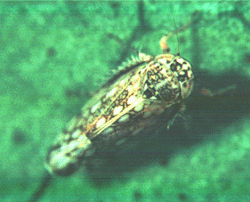Subfamily Deltocephalinae: Tribe Opsiini
 The Common Brown Leafhopper
The Common Brown Leafhopper
Orosius argentatus (Evans)
The Opsiini have been divided into four subtribes, only one of which, the Opsiina, occurs in Australia. The Australian Opsiina include some of our most economically significant leafhopper species. Orosius argentatus, the common brown leafhopper, is well known as a vector of plant phytoplasma diseases in Australia. Hishimonus passiflorae is another extremely common species that is found on a wide range of plant species in gardens. It is known as a pest of passionfruit vines. Overseas, species of Hishimonus are known as disease vectors but no Australian species of the genus has been associated with transmission of diseases. In addition to Orosius and Hishimonus the Opsiini of Australia includes the genus Austrimonus and the introduced Opsius stactogalus which feeds on tamarix and Japananus hyalinus which lives on Japanese maples.
The species are generally small leafhoppers with two aedeagal shafts in the males with a gonopore near the apex of each. In Orosius and Opsius the shafts are fairly simple but in species of Hishimonus and Austrimonus the shafts have accessory processes that may be attached to the shaft or independent.
Opsius stactogalus is green with small pale blue spots scattered over the surface. Orosius species are mainly pale with a distinctive dark brown pattern that can be quite extensive. Hishimonus species are short stubby species with a variety of colour patterns. Species of Hishimonus have a triangular patch on each tegmen that forms a diamond shape in the middle of the back when the tegmina are folded. This distinctive feature is also found in the Oriental genus Hishimonoides Ishihara and the African genera Naevus Knight and Litura Knight and these were grouped as the Hishimonus group by Knight (1973).
- Species of Opsiini known to occur in Australia
- Link to keys for New Zealand Opsiini
- Species of Opsiini known to occur in eastern Indonesia and New Guinea
- Return to previous key page (cica78.htm)
- Restart key
Species of Opsiini known to occur in Australia
Subtribe Opsiina |
|
Genus Austrimonus Fletcher & DaiAustrimonus Fletcher & Dai 2018: 311 [Update: added 28.ii.2018] |
|
Austrimonus apicalis Fletcher & Dai Austrimonus apicalis Fletcher & Dai 2018:
312 [Update: added 28.ii.2018] |
NSW, NT, Qld, Vic, WA |
Austrimonus biapicalis Fletcher & Dai Austrimonus biapicalis Fletcher & Dai 2018: 324 [Update: added 28.ii.2018] |
WA |
Austrimonus bidentatus Fletcher & Dai Austrimonus bidentatus Fletcher & Dai 2018: 323 [Update: added 28.ii.2018] |
Qld |
Austrimonus clavatus Fletcher & Dai Austrimonus clavatus Fletcher & Dai 2018: 323 [Update: added 28.ii.2018] |
WA |
Austrimonus curvatus Fletcher & Dai Austrimonus curvatus Fletcher & Dai 2018: 314 [Update: added 28.ii.2018] |
Qld |
Austrimonus flagellatus Fletcher & Dai Austrimonus flagellatus Fletcher & Dai 2018: 317 [Update: added 28.ii.2018] |
Qld, PNG |
Austrimonus koebelei Fletcher & Dai Austrimonus koebelei Fletcher & Dai 2018: 313 [Update: added 28.ii.2018] |
NSW |
Austrimonus litorus Fletcher & Dai Austrimonus litorus Fletcher & Dai 2018: 314 [Update: added 28.ii.2018] |
NSW, Qld |
Austrimonus luteus Fletcher & Dai Austrimonus luteus Fletcher & Dai 2018: 317 [Update: added 28.ii.2018] |
NT, Qld, PNG |
Austrimonus melaleucae (Kirkaldy) Eutettix melaleucae Kirkaldy 1907: 53 Known hosts: Melaleuca (Myrtaceae) (Kirkaldy 1907), Melaleuca quinquenervia (Day and
Fletcher 1994) |
Qld |
Genus Hishimonus IshiharaHishimonus Ishihara 1953: 38 |
|
Hishimonus diffractus Dai, Fletcher & Zhang Hishimonus diffractus Dai, Fletcher & Zhang 2013: 311 Note: This species is probably adventive in Australia. |
NSW, Lord Howe Is., Qld, SA, WA, Thailand, China |
Hishimonus festivus Knight Hishimonus festivus Knight 1970a: 134 Note: Kamitani, et al. (2011) extended the known range of this species to Indonesia. |
Christmas Island, Indonesia (W. Java) [update: 26.x.2012] |
Hishimonus leichhardti Fletcher & Dai Hishimonus leichhardti Fletcher & Dai 2013: 423 [urn:lsid:zoobank.org:act:70C80D59-B4D3-47F3-BB4D-7E7F4FE18A31] [Update: added 1.xi.2013] |
Qld |
Hishimonus malipatili Fletcher & Dai Hishimonus malipatili Fletcher & Dai 2013: 427 [urn:lsid:zoobank.org:act:F88E8E07-F63F-4DBC-9409-D34C3942BED0] [Update: added 1.xi.2013] |
NT |
|
Qld |
Hishimonus passiflorae (Evans) Eutettix passiflorae Evans 1941:
40 Known hosts: Passiflora edulis (Passifloraceae) (Evans 1941) |
NSW, Qld,
Lord Howe I., PNG, Fiji |
Hishimonus spatulatus Fletcher & Dai Hishimonus spatulatus Fletcher & Dai 2013: 426. [urn:lsid:zoobank.org:act:2D87914B-98A7-4B22-A624-A789FC85F288] [Update: added 1.xi.2013] |
Qld |
Genus Japananus BallJapananus Ball 1931: 218 Note: This genus was transferred from the Scaphytopiini to the Opsiina by Zahniser and Dietrich (2013) [update: 4.vii.2013] |
|
Japananus hyalinus (Osborn), the Japanese Maple leafhopper Platymetopius hyalinus Osborn 1900:
501 Known hosts: Acer palmatum (Ball 1931) |
NSW, NZ?, Japan, N. America [update: NZ added 22.ii.2002] |
Genus Opsius FieberOpsius Fieber 1866: 505 |
|
Opsius stactogalus Fieber, the tamarisk leafhopper Stactogalus Amyot 1847:
217 (invalid monomial) Known hosts: Tamarix spp. (Tamaricaceae) |
ACT, NSW, Qld, SA, Vic, WA,
Europe, N. Africa, N. America, Hawaii |
Genus Orosius DistantOrosius Distant 1918: 85 |
|
Orosius albifrons Fletcher and Löcker Orosius albifrons Fletcher and Löcker in Fletcher et al. 2017: 14 [update: added 3.ix.2016; image added 26.x.2016] |
WA (Barrow Island) |
Orosius argentatus (Evans), the common brown leafhopper Thamnotettix argentata Evans 1938a:
15 Note: This is one of the best known vectors of plant phytoplasma diseases in Australia. Ghauri (1966) considered Ishihara's illustrations of O. orientalis (Matsumura) to represent O. cantonis Oman. Linnavuori (1975a) in synonymising O. cantonis with O. argentatus noted that Ishihara's (1963) description of Nesophrosyne orientalis (Matsumura) may also therefore be this species. Kwon and Lee (1979) formally proposed this synonymy based on the close similarity of the male genitalia of both forms. However recent molecular analyses (Fletcher et al. 2017) has demonstrated that the two species are distinct although both are present in Australia.The distribution of both species needs to be checked although O. orientalis is the species found in Asia, extending into Western Australia with some records from eastern Australia while O. argentatus is distributed mainly in eastern Australia with some records from Western Australia. Ghauri (1966) recognised the form from New Britain as subspecies O. argentatus novaebritanniae Ghauri and noted that the form from Java was coloured differently from the typical form. Fletcher et al. (2017) transferred both forms to synonymy with O. orientalis. References in the literature to O. argentatus in India and to O. orientalis in Israel are probably misidentifications of O. albicinctus Distant, which doesn't occur in Australia. Known hosts: common on a wide variety of plants in many families, although it appears to be particularly associated with Chenopodiaceae. [update: 3.ix.2016] |
ACT, NSW, NT, Qld, Vic, WA, NZ, Norfolk Is., Fiji, Polynesia, Java, Melanesia, New Britain [WA, NZ update: 6.ii.2001] |
Orosius brunneus Fletcher and Löcker Orosius brunneus Fletcher and Löcker in Fletcher et al. 2017: 17 [update: added 3.ix.2016; image added 26.x.2016] |
WA (Barrow Island) |
Orosius canberrensis (Evans) Thamnotettix canberrensis Evans 1938a: 15 |
ACT, NSW, NT, Qld, SA, Vic, WA [Qld update 10.viii.2000; SA, NT update 14.vii.2011] |
Orosius cellulosus (Lindberg) Thamnotettix cellulosus Lindberg 1927: 90 Note: This species was first recorded in Australia by Fletcher et al. (2017) although there is a possibility that the Australian material is not O. cellulosus but an undescribed species. |
NSW, Africa |
Orosius lotophagorum (Kirkaldy) Allygus lotophagorum Kirkaldy 1907: 62 Known hosts: Sida (Malvaceae), Boerhavia (Nyctaginaceae), Portulaca (Portulacaceae), Sesuvium (Aizoaceae) (Linnavuori 1960a: 322) |
NSW, NT, Qld,
Philippines, Polynesia,
Melanesia |
Orosius magareyi Fletcher and Löcker Orosius magareyi Fletcher and Löcker in Fletcher et al. 2017: 16 [update: added 3.ix.2016; image added 26.xi.2016] |
SA |
Orosius orientalis (Matsumura) Eutettix orientalis Matsumura 1914: 192 Note: This oriental species is a well known vector of plant phytoplasma diseases in Asia. In external appearance and the structures of the male genitalia, this species is very similar to O. argentatus which is more common in eastern Australia while O. orientalis is more common in Western Australia (Fletcher et al. 2017). [update: 3.ix.2016] |
NSW, WA, New Guinea, China, Taiwan, Japan, Indonesia |
Orosius pallidus Fletcher and Löcker Orosius pallidus Fletcher and Löcker in Fletcher et al. 2017: 17 [update: added 3.ix.2016; image added 26.x.2016] |
SA |
Orosius recurvus Fletcher and Löcker Orosius recurvus Fletcher and Löcker in Fletcher et al. 2017: 16 [update: added 3.ix.2016; image added 26.x.2016] |
NSW |
Orosius ryukyuensis (Ishihara) Nesophrosyne ryukyuensis Ishihara 1965: 19 Note: This species was reported, as O. lotophagorum ryukyuensis, by Behncken (1984) from Ipomoea (Ranunculaceae) in Queensland based on identification of specimens by M.S.K. Ghauri in 1977. [update: 3.ix.2016; image added 26.x.2016] |
Qld, Japan |
